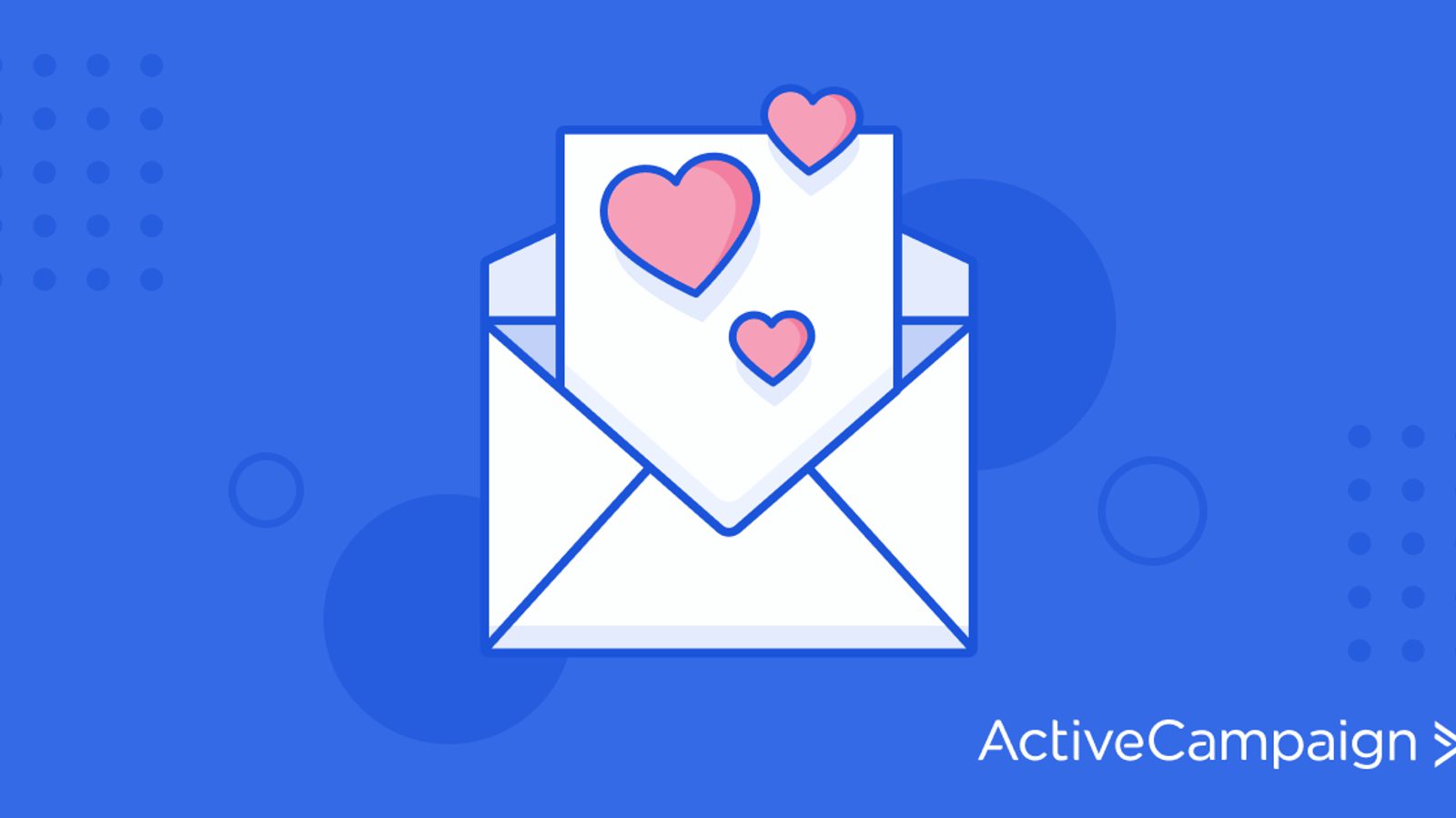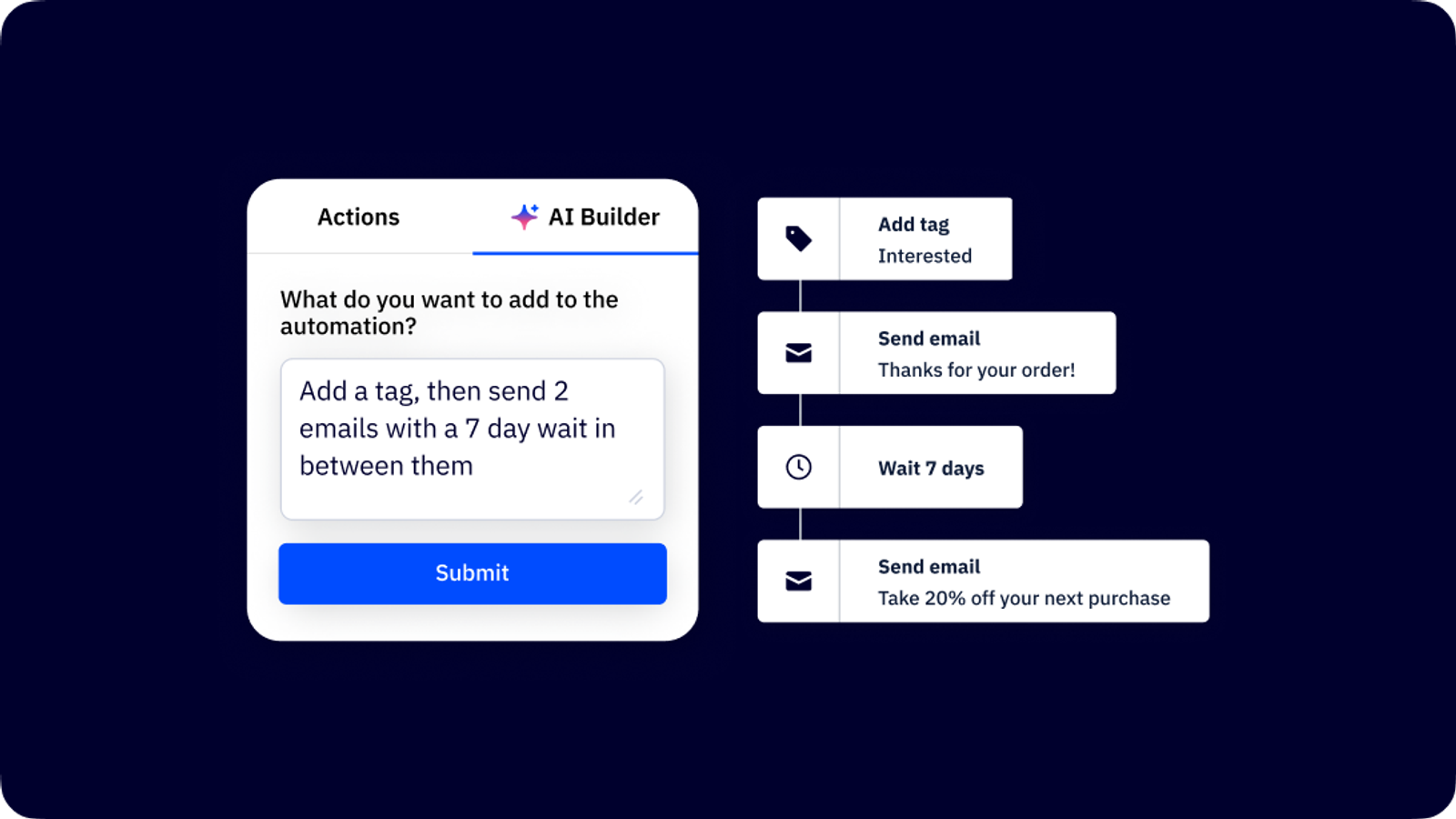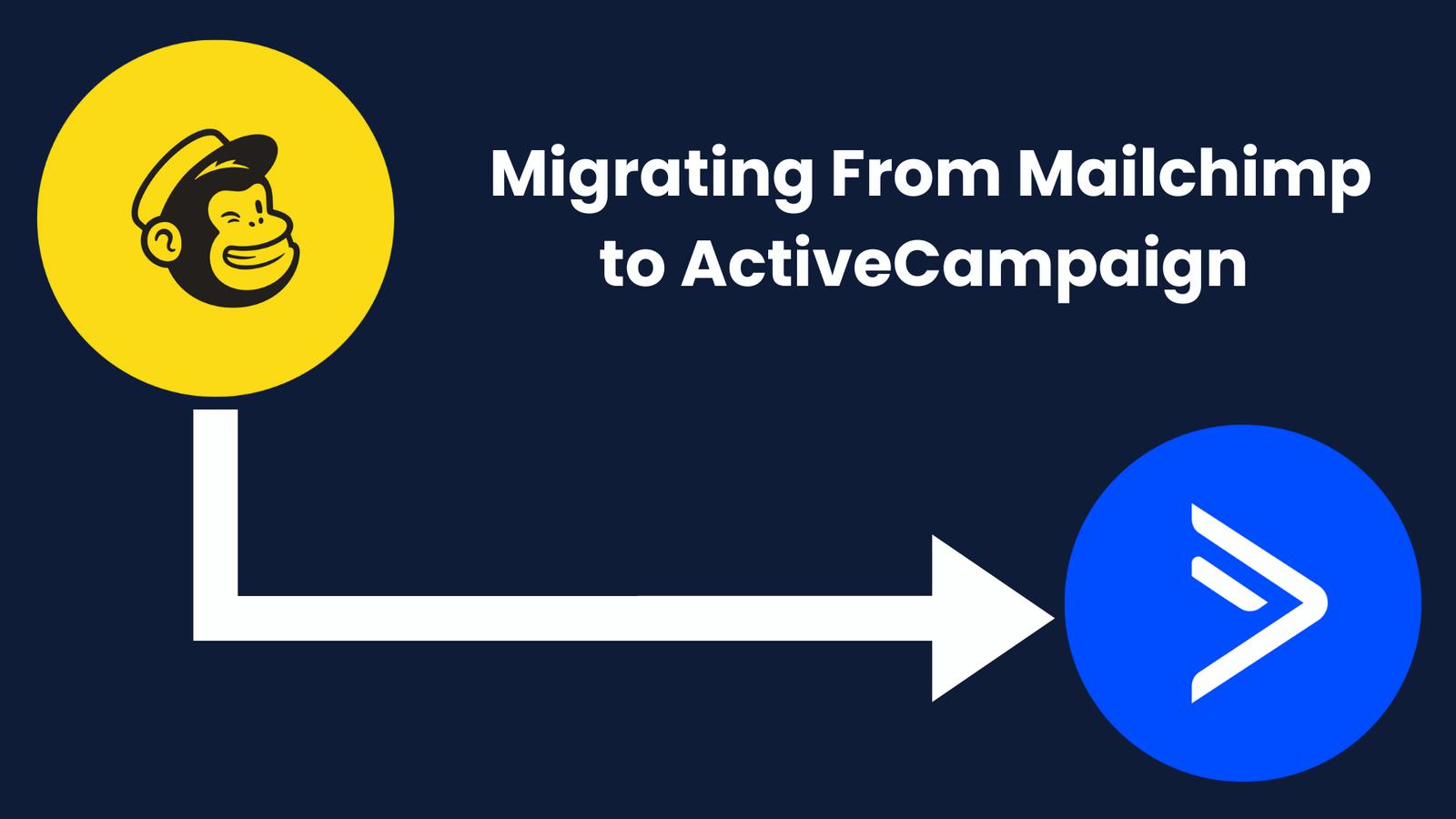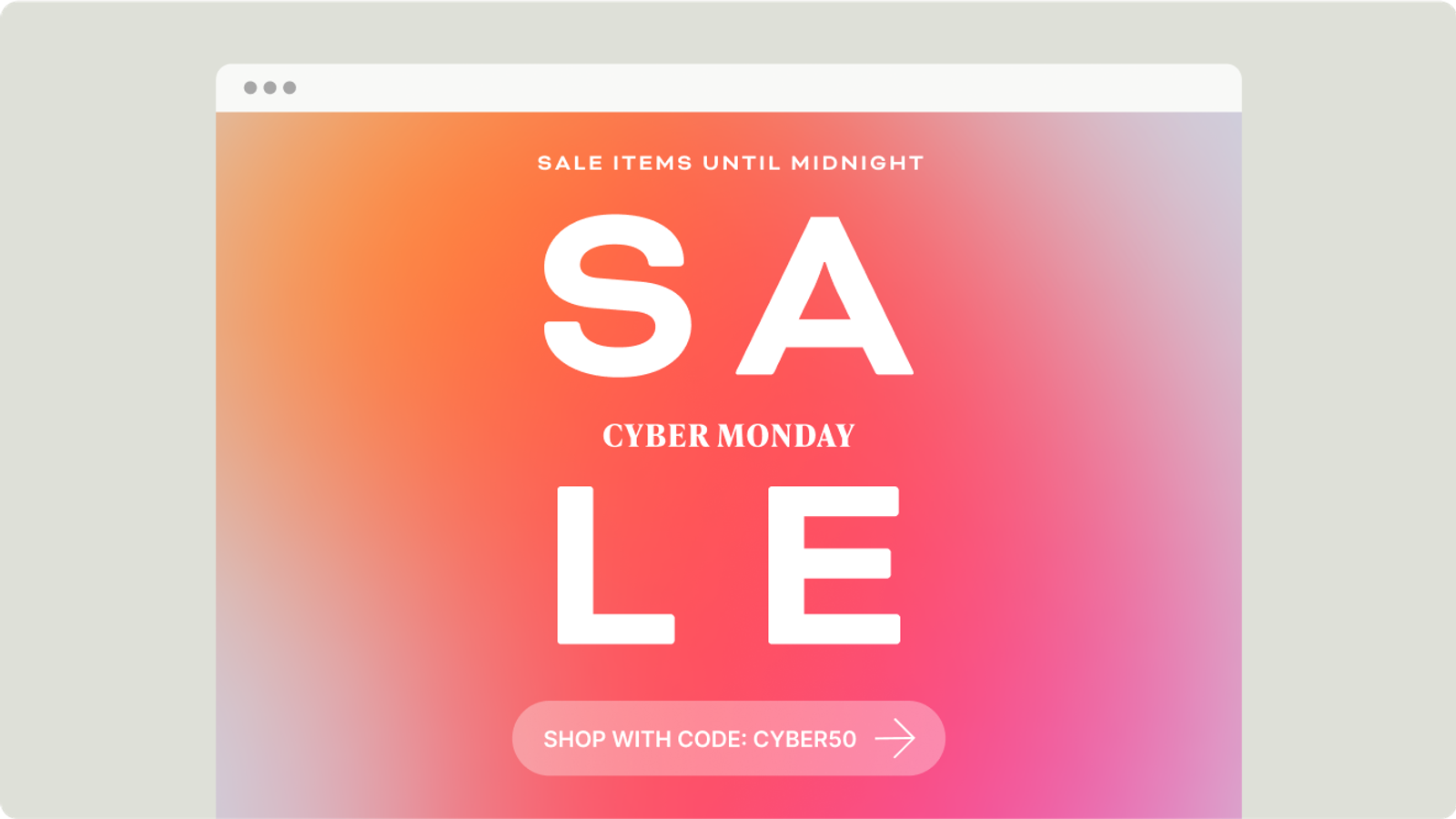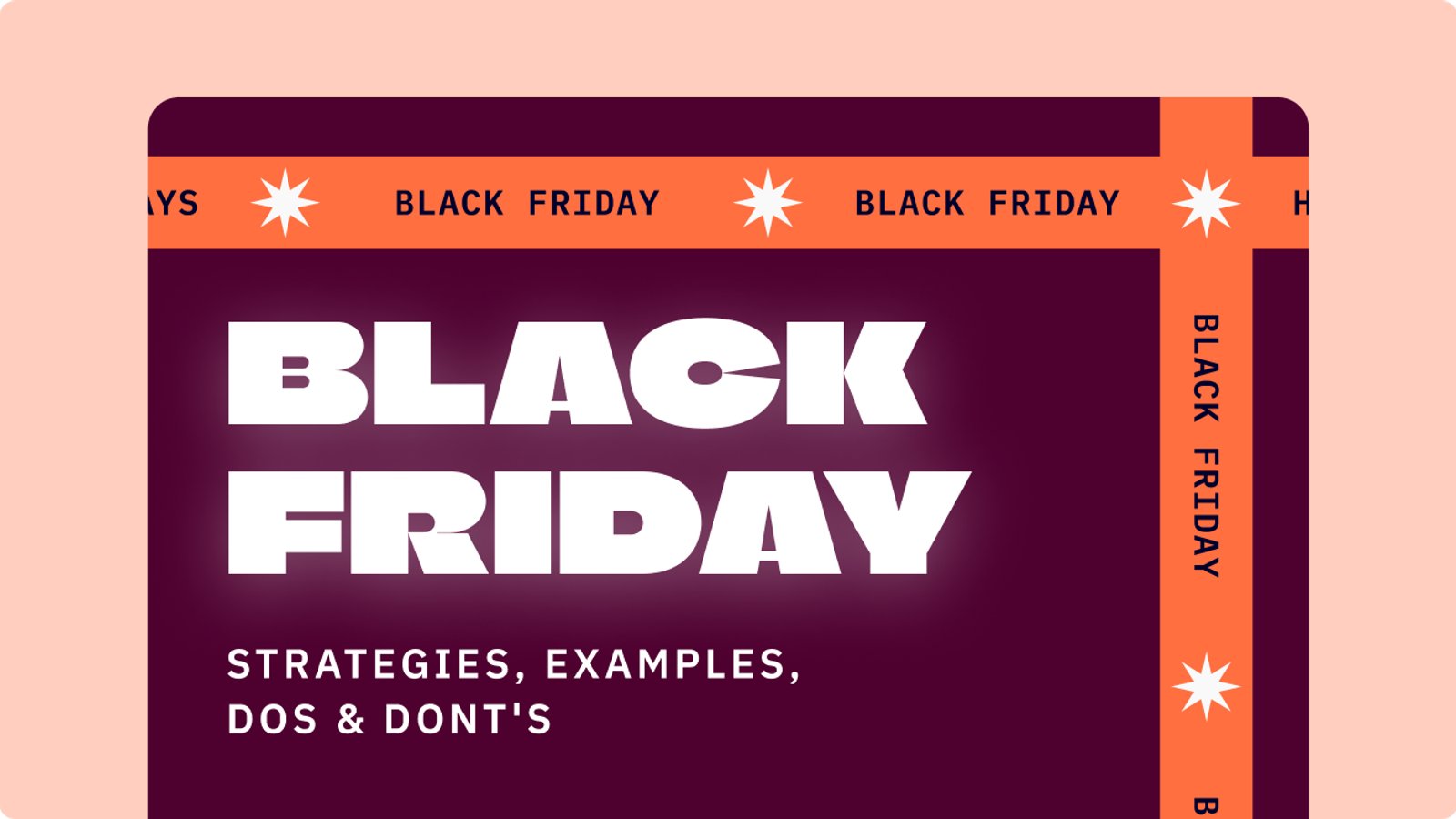Every year nearly one in four of your email subscribers decide they don’t want your e-commerce emails anymore.
It's not fun to lose hard-won customer interest after you put in so much effort to build a great email list, especially when 40% of your revenue comes from repeat customers.
Those unsubscribed email notifications can feel just so...abrupt. Dismissive, even.
You thought you had a good thing together. They thought...well, they must have thought differently.
Often an unsubscribe is the final outcome of a hidden problem: 60% of your customers are ignoring your emails at any given time.
But it’s not too late! If they haven't unsubscribed yet, you can regain the interest of even the most radio-silent of your lapsed customers...with a win-back email campaign.
You’re about to learn some stuff about win-back email campaigns:
- What is a win-back email campaign?
- How to tell when a customer needs to be won back
- How to segment your email list by customer engagement (and why you need it to win people back)
- How to make an effective win-back email campaign
- The 5 types of win-back emails you should send — with great examples you’ll wish you thought of first
- Why your subscribers become inactive, and how marketing automation can keep them interested
What is a win-back email campaign?
A win-back email campaign is an email sent to reengage inactive contacts who have made purchases or signed up for your email list but stopped opening your emails. The goal of a win-back email is to get people to interact with your emails and call to action again.
A great win-back email can work all on its own — but a win-back email series of strategically timed and targeted messages can be even more effective.
A win-back email can come in many varieties, including abandoned cart emails and "We miss you" emails.
But why should you care about winning back a customer who ignores your emails? Why invest time and energy in someone that isn’t interested in you? That can’t be good self-care, can it?
A win-back email campaign is vital because it costs five times more to get a new customer than it does to keep a loyal customer you already have.

Find your business’s true fans and get them to keep buying from you.
And loyal customers are:
- Four times as likely to refer you to other people
- Five times as likely to buy from you again
- Seven times as likely to try your new products
Get this — a whopping 45% of customers who get a win-back email will open your future emails. Effective customer win-back email campaigns remind your customers why they were interested enough to subscribe to your list in the first place — and that rekindled interest can lead them to buy from you again.
Try it now, for free
When should you send a win-back email?
You should send a win-back email 3 months after a customer has stopped engaging with your emails. After 6 months, a win-back email may be less effective at bringing your customers back.
Your win-back emails depend on your business, your product, and your customers.
If you sell expensive or one-time purchases, customers may not need to buy from you again right away. If you have very long sales cycles, it may be common for people to disappear for a few months before coming back and suddenly making a purchase.
A win-back email series will make it easier for you to recover customers. Instead of disappearing forgotten on the list of their email subscriptions, you can show up in their inbox right when they're considering a purchase.
The 5 messages of your win-back email sequence (with examples)
If you only send one email, you only have one chance to get your customers to come back.
A series of 5 emails, on the other hand, gives you 5 chances – and lets you try a variety of different tactics, so you can find the ones that get the most people.

These are the 5 emails to send in your automated win-back campaign
We recommend sending 5 types of win-back email sequences, in this order:
- Remind people you exist. Things happen, and a simple “hello” email will get some people to start interacting with your messages again.
- Offer an incentive. If a “hello” wasn’t enough, offering an incentive can nudge people who are on the fence about buying again.
- Ask for feedback. People like giving their opinions. Even if they don’t buy, you get information that can help you improve your marketing.
- A last-chance email. Tell people that you’ll unsubscribe them unless they respond to this email.
- Unsubscribe. You’ve unsubscribed the contact, but let them know in case they want to come back.
How long should you wait between each email? We recommend you send your first email roughly 3 months after your customer’s last interaction and wait at least a month between each remaining email of this series.
Again, here are the 5 emails you can use to create an effective win-back email campaign:
- The “hello” win-back email
- The incentive win-back email
- The feedback win-back email
- The cleaning-house win-back email
- The unsubscribe win-back email
Win-back email 1: The “hello” win-back email
Does it warm your heart when people think about you...or even better yet, reach out and let you know you’ve been on their mind?
Of course, it does, and it does for your customers too. In fact, over 60% of consumers get frustrated if their loyalty isn’t recognized. And remember: Your competitor is only one mouse click away.
The “hello” welcome back email should accomplish these 4 goals:
- Remind your customer why they became your customer in the first place
- Show the awesome benefits of your product provides
- Make your customer feel recognized and appreciated
- Keep your brand fresh in your customer’s mind

Takeaways from this win-back email:
- Keep it simple. Inactive customers don’t want to read a lot of copy. This welcome-back email from Asana keeps things brisk and to the point.
- Remind customers of benefits. Sometimes people simply get distracted and just need a little nudge to remember all the great benefits you provide
- Use a low-friction call-to-action. Make it easy for your customer to come back with a call-to-action that politely asks — instead of demands
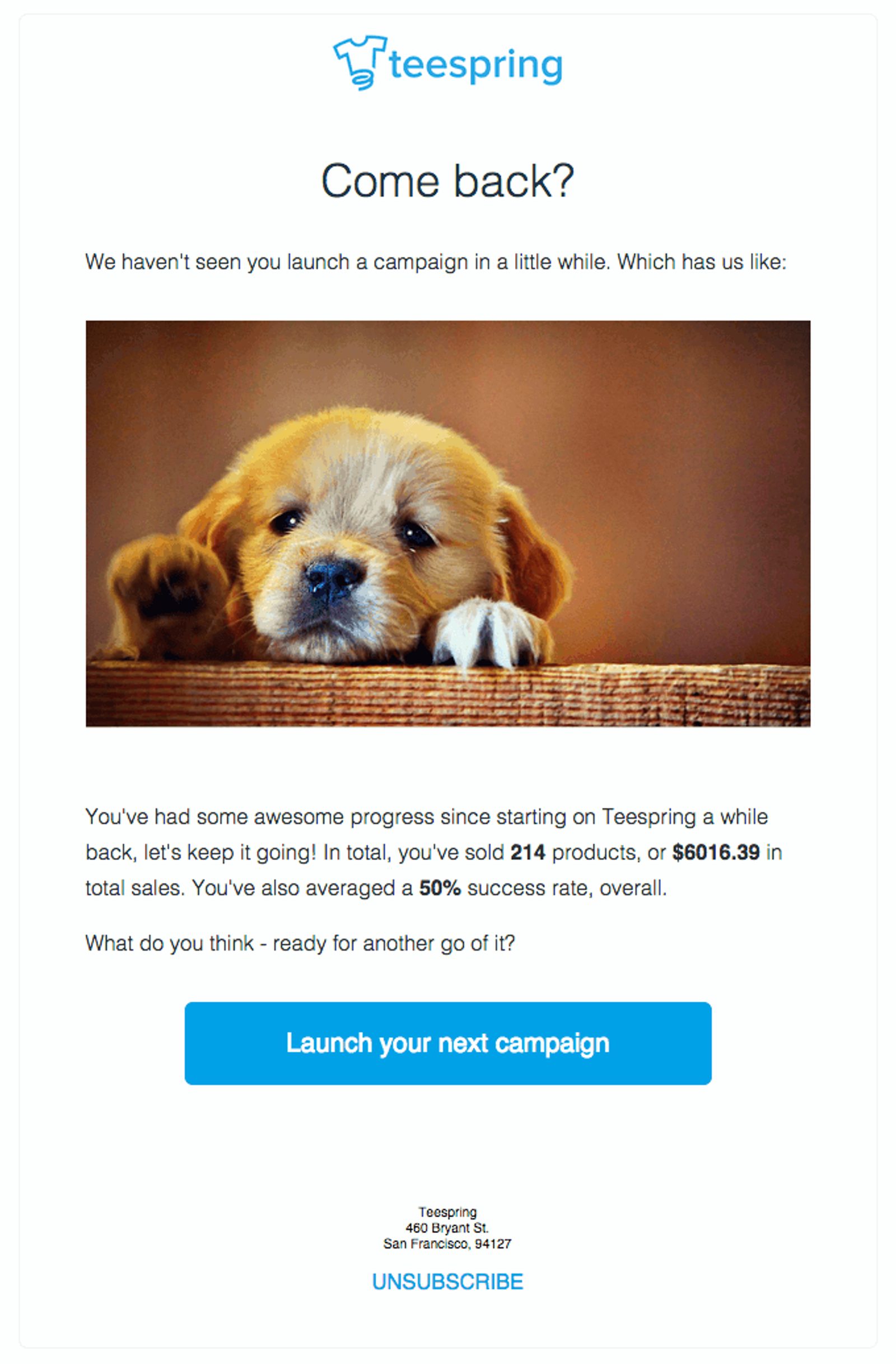
Takeaways from this win-back email:
- The Awww Factor. There’s a reason a LOT of win-back emails feature cute animals. That’s because everyone loves a cute pet. You’re more likely to read this email from Teespring because it caught your attention with the saddest pupper.
- It’s not about you. If you track your customer’s information, use it in your win-back email copy. It’s great to show what your product does for your customer...but a reminder of what they’ve already accomplished with your product is better.
Win-back email 2: The incentive win-back email
Not everyone will come back just because you said “hello.” Because you send a “hello” email to disengaged customers, a lot of them probably won’t even open it!
Even though coupons can often be risky, an email campaign to win back customers is a great time to offer an incentive.
Your incentive to win back a lost customer doesn’t have to be a discount code, either. You can also offer:
- A bonus gift
- Free shipping
- Free upgrades
- Extra reward points
- Sweepstakes and prizes
- A free consultation
- Personalization
Bonus tip: Are you more likely to click “add to cart” if you have a $10.00 discount code coupon, or a 10% off coupon? A study conducted on win-back campaigns found that emails that offered discounts of dollar amounts (instead of a discount code) perform better.

Takeaways from this win-back email:
- Offer what they want. As a beauty subscription business, Birchbox is well aware that a Beautyblender is a must-have for most make-up aficionados (I have three). Getting a free cleanser (and saving 20 bucks) is a pretty sweet deal. Know your audience.
- Incentives don’t have to be a discount. A product incentive is often a stronger draw than a blanket discount because it offers something tangible the customer can anticipate
- Create urgency. This deal is only available if you sign up in time for the next month’s box...and that ticking clock creates FOMO
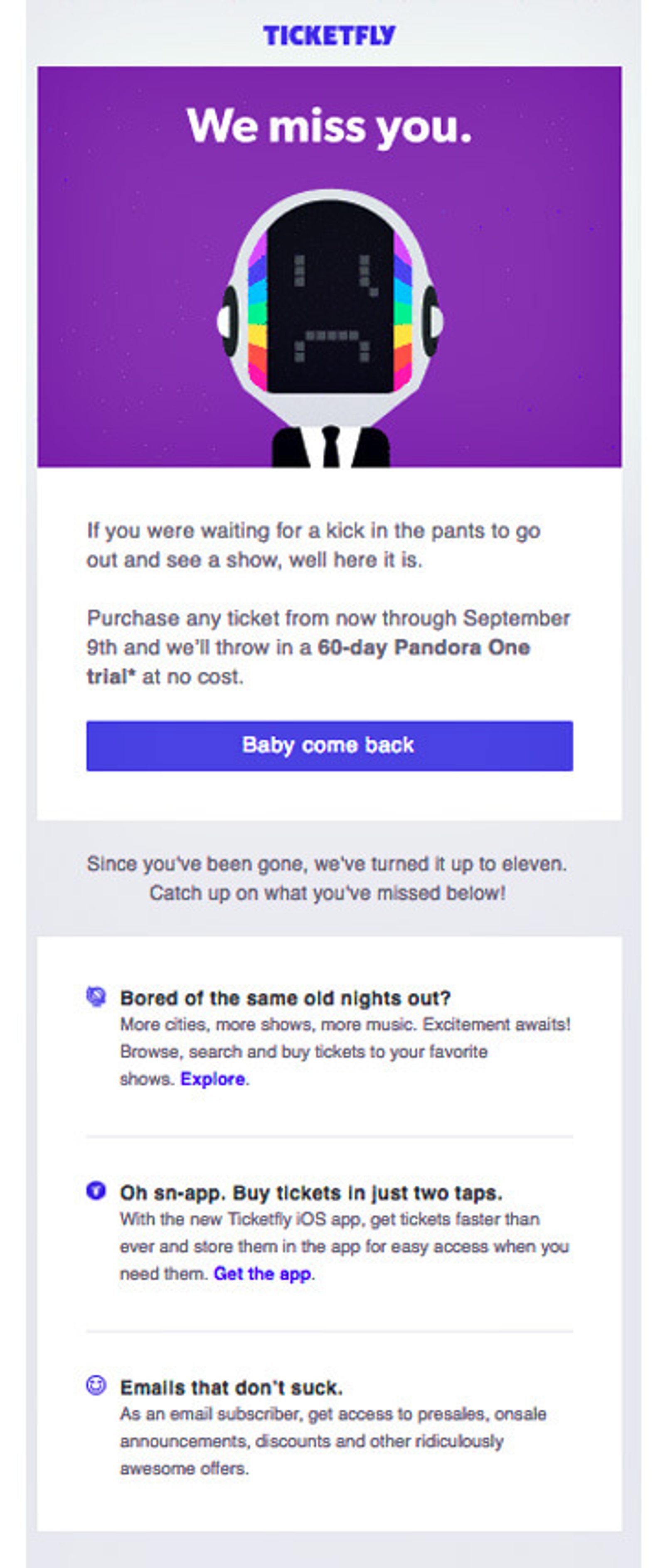
Takeaways from this win-back email:
- Keep customers in the loop. If you don’t know why your customer has started to avoid you, tell them about your recent improvements. There’s a chance their inactivity is because of a problem that’s now fixed.
- Use a related incentive. Maybe your business model doesn’t support incentives easily. Offer a related incentive (like Ticketfly does with a 3-month Pandora music subscription) and your customer is more likely to respond.
Win-back email 3: The feedback win-back email
Feedback emails ask lapsed customers why they’ve moved on. They serve two main purposes:
A feedback email might be enough to get customers back if you can show that their satisfaction is your top priority
The feedback tells you how to improve your emails, your e-commerce experience, and your customer service
And as a bonus...people like giving their opinions. Even if you can’t get them to purchase, asking people for their perspectives is one way to get them to interact with your email.
82% of consumers in the US have stopped doing business with a company because of a bad customer experience. There’s a chance that’s why you’ve lost a customer — and why they’ve not been won back by your earlier “hello” and incentive emails.
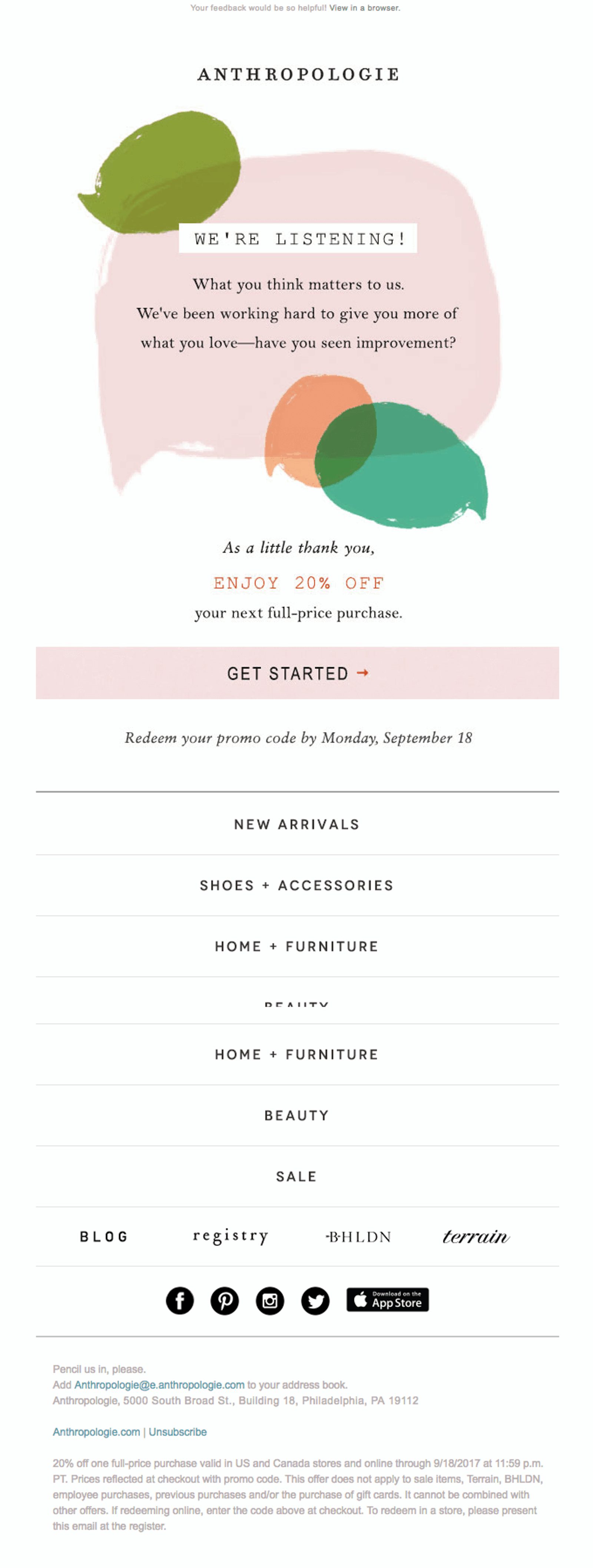
Takeaways from this win-back email:
- Give your customers a reason to respond. People are more likely to take the time to fill out a feedback survey if you offer them an incentive, like the discount code in this welcome-back campaign from Anthropologie.
- Be direct. Anthropologie isn’t coy — they straight-up ask, “Have you seen improvement?” A direct question is more likely to get back answers you can actually use to make improvements.
- Empathy goes a long way. When a customer is on the fence, the knowledge that you care about their experience can be what makes them give you another chance.
Win-back email 4: The cleaning-house win-back email
This email is your last-ditch effort to convince a disengaged customer to come back.
The email tells the subscriber that if they don’t click the CTA to remain on your mailing list, you’ll remove them from the list in X days (a good rule of thumb for X is 30 days).
If they ignore your email, you move on. If they click through to stay on your list, you can try to win them back again with a future campaign.
This re-permission win-back email serves two purposes:
It may motivate some people to engage because the fear of losing something is often a more powerful motivator than the chance to gain something.
It keeps your list clean of inactive subscribers, which improves your email deliverability rate and reduces email bounce backs
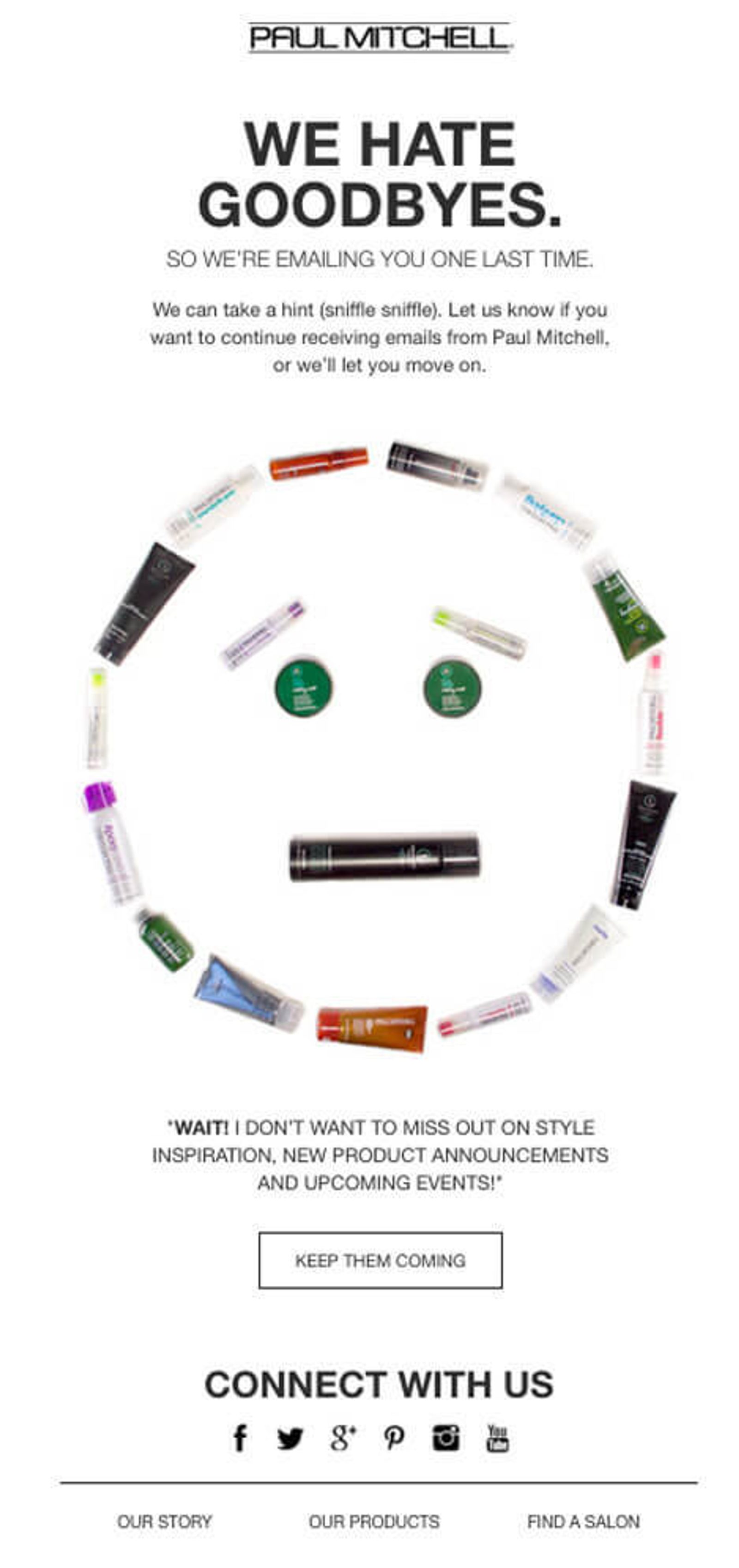
Takeaways from this win-back email:
- Keep it light. The topic in this email from Paul Mitchell might be serious (the customer will be removed from Paul Mitchell’s mailing list) but the language and design remain playful. No one likes a guilt trip, so don’t burn your bridges with accusatory language.
- Let customers know what they’ll lose. The urgent reminder of all the great benefits the customer will lose will make some people click the CTA to “keep them coming.”
- Make customers decide. Your email deliverability suffers from a dead list. If you make people click to opt-out, you can’t tell if they really decided to stay on your list...or if they just ignored another one of your emails.
Win-back email 5: The unsubscribe win-back email
An unsubscribe doesn’t always mean a customer never wants to hear from you again. They just might not want to receive your emails right now. Sometimes customers decide they want back on your email list after they’ve clicked “unsubscribe.”
An unsubscribe email can still recapture the attention of your customers if they’re on the fence, so your unsubscribe message is your last chance to make that happen.
If your unsubscribe email is impersonal, that just reinforces the customer’s choice to leave. Provide great customer service even as they unsubscribe and they’ll be more likely to return to you in the future.
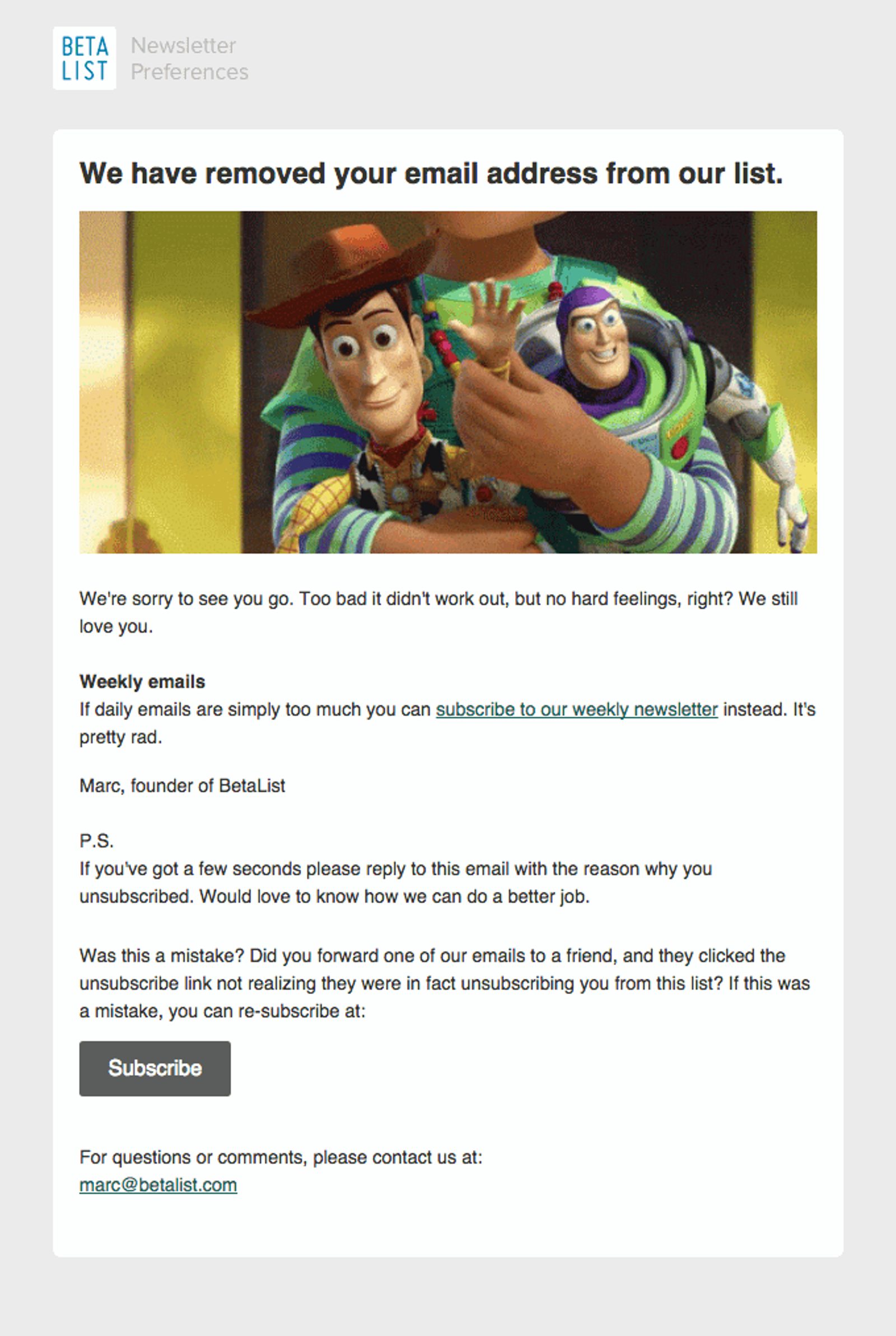
Takeaways from this win-back email:
- Give customers the benefit of the doubt. Hey, mistakes happen. Sometimes unsubscribes really are an accident. BetaList includes a CTA to resubscribe...just in case.
- Give customers options. Maybe your customers wanted your emails...but not so damn many. If your customer can subscribe to another list and get emails less frequently, definitely let them know.
- Be real. You now know the founder of BetaList is Marc. He’s a real person, and he’d love to know what he can do to improve BetaList for other customers....and for you, if you want to return.
- Keep the door open. Maybe your customer had a major life change and you don’t fit into their life right now. Maybe they plan to return when things have settled down. They won’t if you make the unsubscribe experience unpleasant.
How to tell when a customer needs to be won back
How do you even know if a customer has ghosted your e-commerce business and needs to be won back? Take a walk down memory lane...
- How long has it been since your customer opened any emails?
- How long has it been since they clicked on an email call-to-action (CTA)?
- How long has it been since they bought something from you?
Ok, cool, you get it. Easy-peasy, right?
Well, it’s only easy to tell if a customer lapses after you define what a lapsed customer means for your business. That depends on your product — and how you sell that product.
An e-commerce wine business that sells annual rosé subscription boxes will define a lapsed customer differently than an online sneaker store that drops new kicks every Friday at exactly 11:11 am. And both of those businesses will define a lapsed customer differently than someone who sells custom hand-blown glass candlesticks shaped like a giraffe.

It’s easier to win back inactive customers the earlier you catch them.
But here’s a good rule of thumb for how long an e-commerce customer needs to be inactive before they are considered lapsed:
- 3 months of inactivity: Your customer is at risk of lapsing. They’re losing interest.
- 6-9 months of inactivity: Your customer lapses. They no longer interact with your business.
How to segment your email list by customer engagement(and why you need it to win people back)
Why do you need to segment your email list to win back customers?
Because there are different levels of lapsed customers, and these levels dictate which customers to prioritize. A campaign to win back customers isn’t an email blast you send to your entire list or even to all of your lapsed customers.
You can segment your customers with these 3 metrics (calculated over a time span that’s relevant to your business):
- Recency: The time period since their last order
- Frequency: Their number of orders
- Monetary value: The average order value (low, medium, or high)
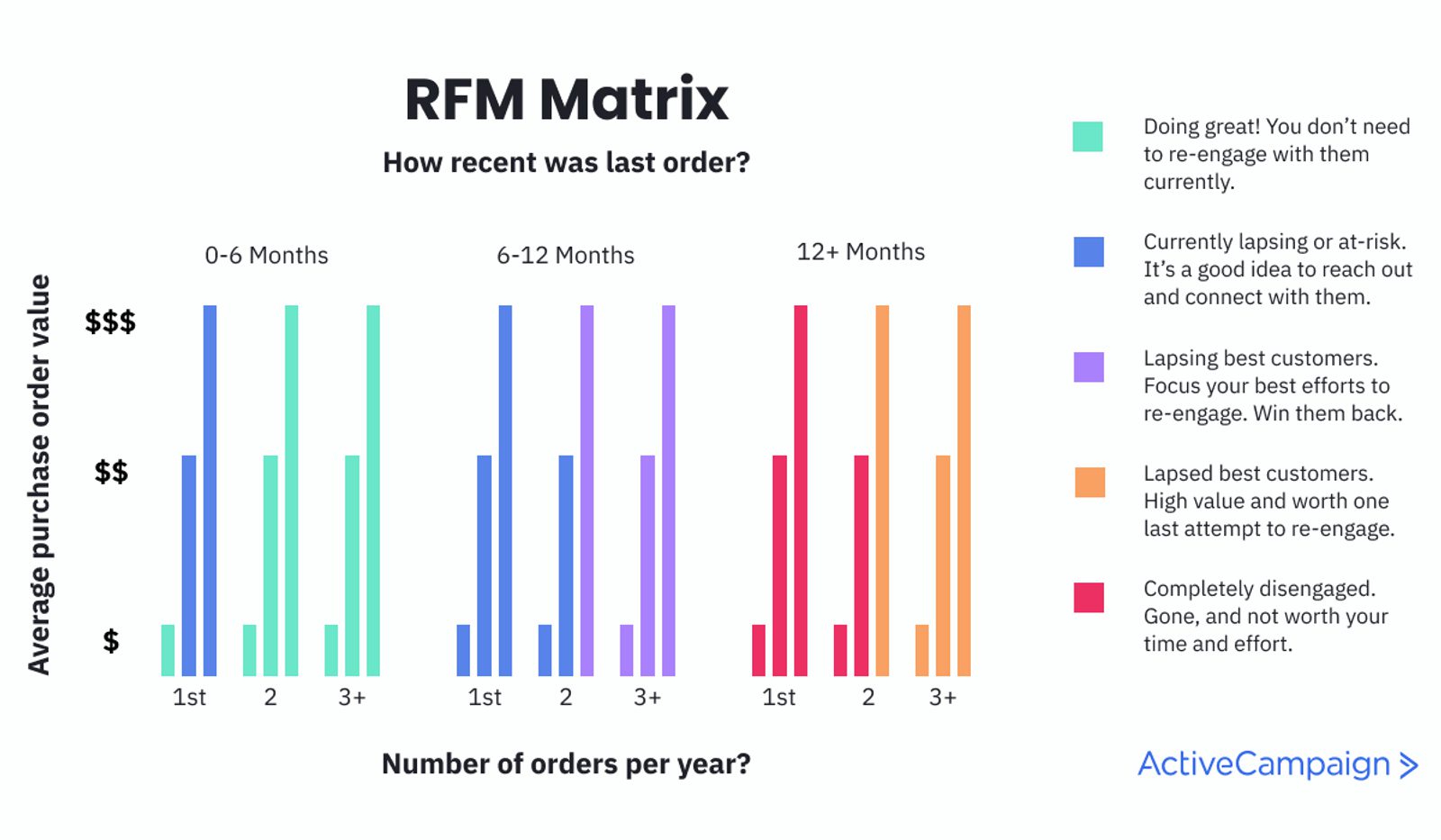
The blue, purple, and orange bars are where you should focus most of your win-back efforts.
Use this information to make an RFM Matrix. Based on where customers fall in the matrix, you’ll know which customers need some extra attention:
- Green are engaged customers. You don’t need to win them back — they’re snug as a bug in a rug
- Blue are lapsing or at risk of lapsing. They’re not disinterested customers yet, but it’s a good idea to reach out to get them back into the green.
- Purple are your lapsing best customers, or “heroes.” They have high average order value and/or frequency. These are the customers that you really want to keep, so focus a lot your re-engagement efforts on them. Win them back!
- Orange are your lapsed best customers. They’ve lost interest, but because of their very high value, it’s definitely worth the effort to win them back. This is where you go big or go home, often with a last-ditch and impossible-to-resist offer.
- Red are likely to be completely disengaged. The train has left the station — all you can do is use these departed customers as an opportunity to learn how to improve.
Your business type and sales cycle determine what your personal matrix looks like, but you get the idea. With your list segmented by customer engagement, you now know who you need to win back with a great customer reactivation strategy.
How to make an effective win-back email campaign
Huzzah! You now have a segmented list of who to send your win-back emails to...but what do you send to these lapsed customers, and when do you send it?
To make a great win-back email campaign that’s impossible for customers to ignore, you need to decide these three things:
- How many emails you should send in your win-back campaign
- What you should include in your win-back emails
- When you should start your email win-back campaign
How many emails should you send in a win-back campaign?
In a previous article on re-engagement emails, we surveyed ActiveCampaign Certified Consultants and asked them, “how many win-back emails should you send?” The consensus was clear — you should send at least three customer win-back emails.
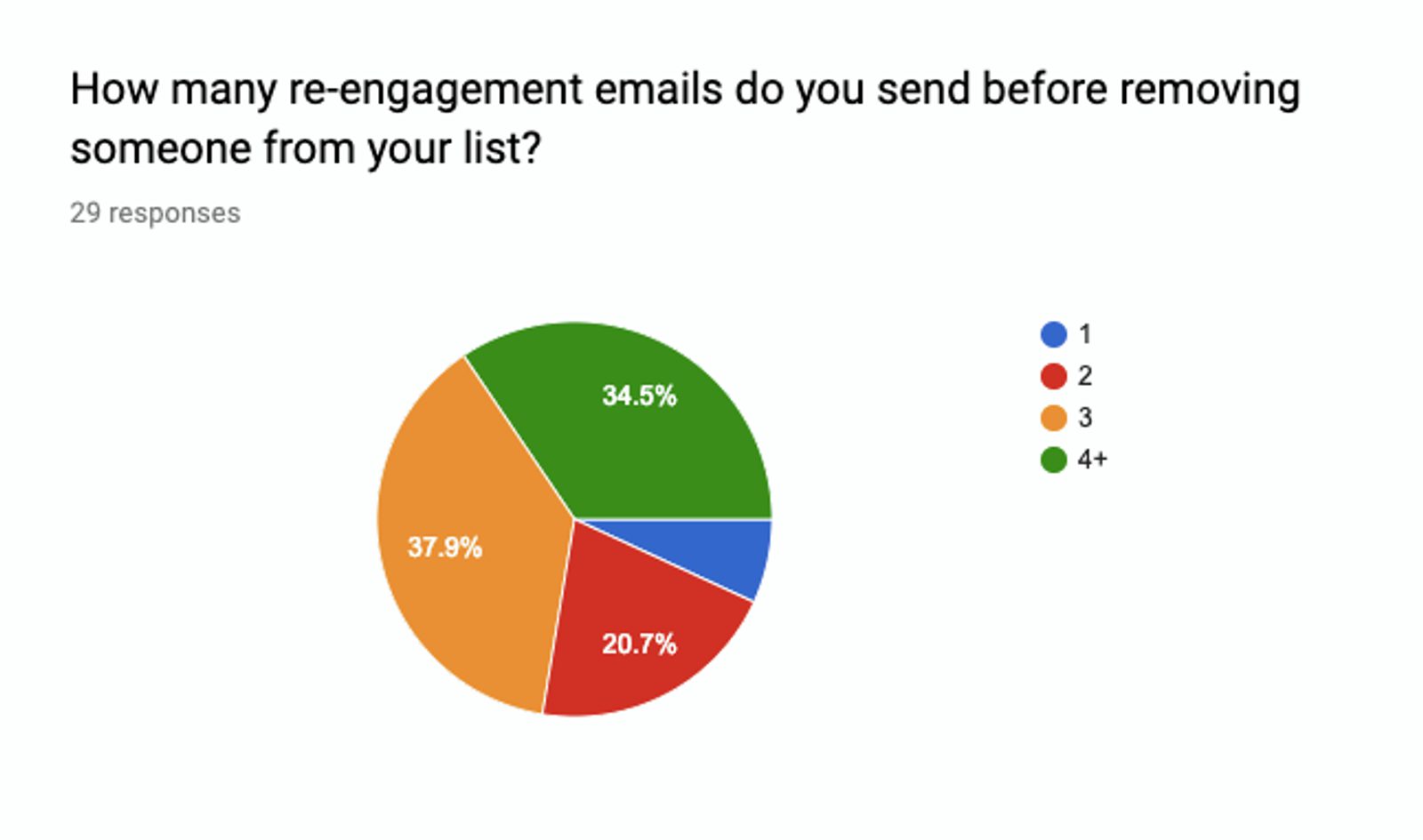
The best customer win-back strategy is to send at least 3+ emails.
If you only send one email, you can only use one persuasion technique. Packing a ton of info into a single email is a good way to confuse your customers – which means a one-email win-back campaign only lets you try one persuasive call to action.
An automatically triggered email sequence lets you try a few different tactics. When you can make multiple offers, you can increase the chance that one of your emails will work.
What should you include in a win-back email?
For a customer win-back email, you should always follow the same best practices you’d use in any other marketing email campaign, but take extra care that you:
- Keep your subject line and copy succinct
- Include only one call-to-action
- Experiment with your tone, but always use the language your customers use
- Use merge tags to personalize your email message
- Remind recipients of exactly what they can get by coming back (usually by including a picture of your product)
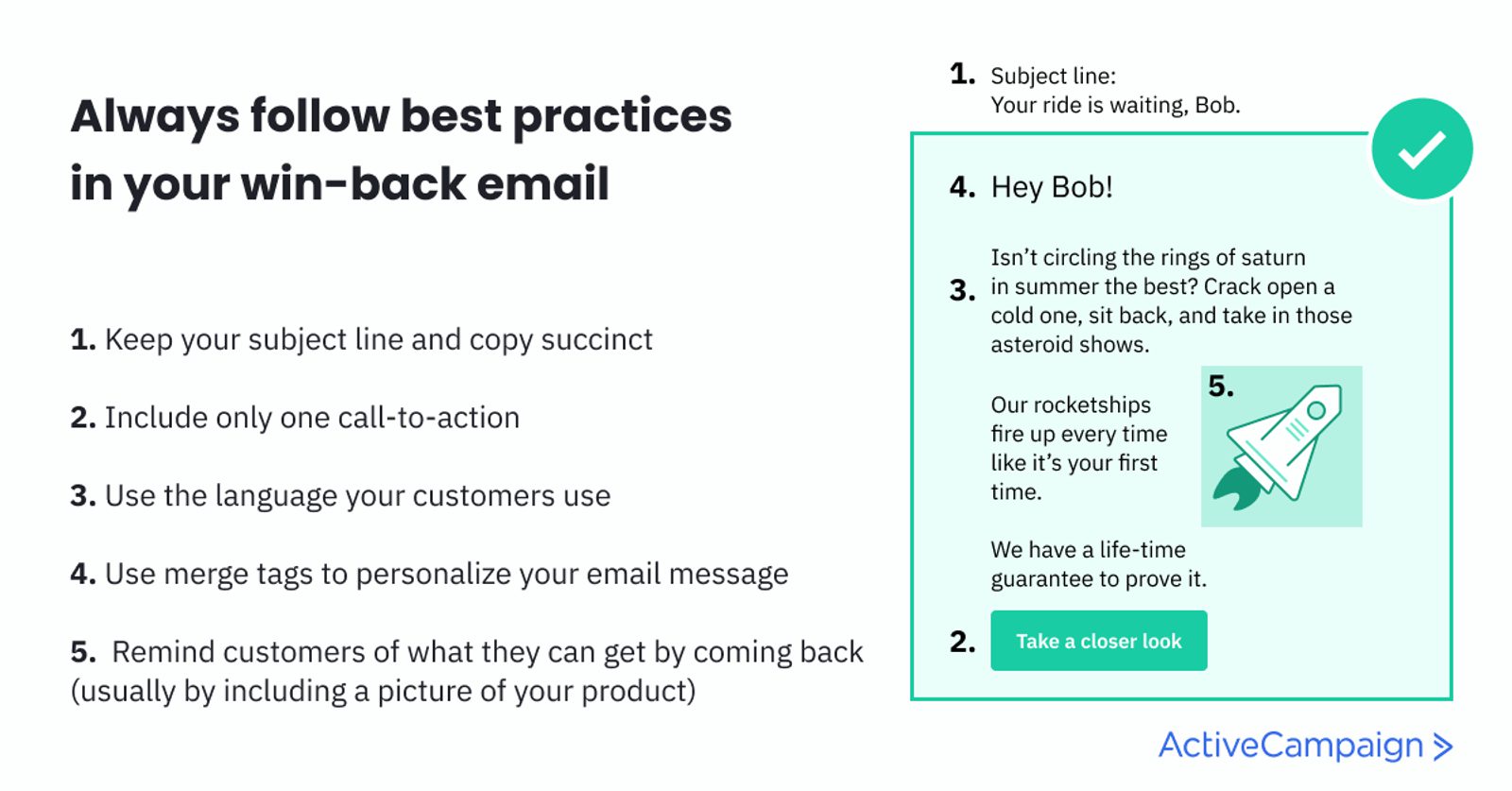
49% of customers like to receive promotional emails from their favorite brands once a week.
Ultimately, the best way to win your customers back is to keep your emails relevant. You don’t have to win back customers who haven’t lost interest.
Here are a few articles that will show you how to make great emails that your customers will want to get:
- Welcome Email Series: A 6-Email Welcome Sequence You Can Steal
- 7 Surefire Tips to Increase Email Engagement (and Keep It Going)
- 20 Email Marketing Examples That You Can Learn from (and Totally Copy)
Or, if you need some inspiration, check out these email templates.
When should you start an email win-back campaign?
It’s up to you how to win back inactive customers. Do you want to do this the easy way...or the hard way?
- The easy way: You touch base with the customer who is still interested in you (but just hasn’t been opening your emails as much as they used to).
- The hard way: You attempt to win back the person who reflexively deletes your emails the moment they appear.
Sometimes the easy way is definitely the best way. You want to start your win-back email campaign as soon as a customer shows early signs of lapsing.
This is how to schedule your win-back email sequence:
- Send your first email roughly 3 months after your customer’s last interaction. Track their engagement with the email. Do they open the email, click a link, or (hopefully) make a purchase?
- Send your follow-up emails in a drip campaign that’s spread equally between your first and last email — that’s usually an email every 1-2 months
- Send your last email when your customers are historically shown to be completely disengaged. If that point is at 9 months of inactivity, you have 6 months from your first email to win them back. Once they pass the cut-off point, remove them from your email list.
Once a customer has fallen back in love with your business again, don’t send them more win-back emails. If someone just needs a simple “hello” email nudge, they’ll be alarmed if they later get an automatic-unsubscribe warning email.
Why your subscribers become inactive – and how marketing automation can keep them interested
“The customer’s perception is your reality.” – Kate Zabriskie
There will always be reasons beyond your control that some customers ignore your emails, like if their inbox is too cluttered. Customer churn happens.
But many of the reasons your customers become disengaged are under your control, like:
- Too many emails: You send emails to your list too often
- Boring subject lines: People take less than 3 seconds to decide if they’ll click on your email
- One-time-deal: They only signed up for your list to receive an incentive, like a “10% off first order for signing up” offer
- Bad Experience: Your customer may be leery of your business if they’ve been burned before
If someone winds up on your e-commerce email list, they probably want updates, sale alerts, or sneak peaks of new products. If you don’t send them content that meets those expectations, their interest will diminish.
ActiveCampaign helps you recapture the attention of your customers with list segmentation...and makes it even easier to never lose customer interest in the first place with a win-back automation series.
Marketing automation lets you create email marketing campaigns that:
- Stay at the front of your customers’ minds
- Send scheduled emails that keep customers interested
- Remind customers of upcoming events, releases, and sales
- Strengthen customer loyalty
- Save time with pre-built templates

ActiveCampaign has a free, pre-built win-back email campaign recipe you can use now.
With relevant emails your customers want to get, you will lower the chances you’ll need to win them back in the future. But with an automated win-back campaign in place, you will be ready for those customers who just need some extra attention to remind them why they love your business.

